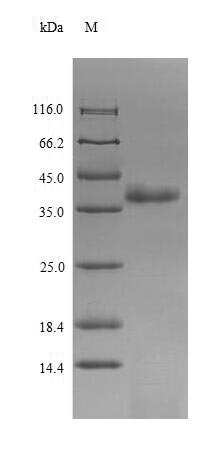Recombinant Chicken anemia virus Apoptin (VP3)
CAT:
399-CSB-EP860325CIDe0-02
Size:
100 µg
Price:
Ask
- Availability: 24/48H Stock Items & 2 to 6 Weeks non Stock Items.
- Dry Ice Shipment: No




Recombinant Chicken anemia virus Apoptin (VP3)
- CAS Number: 9000-83-3
- Gene Name: VP3
- UniProt: Q99152
- Expression Region: 1-121aa
- Organism: Chicken anemia virus (isolate Germany Cuxhaven-1) (CAV)
- Target Sequence: MNALQEDTPPGPSTVFRPPTSSRPLETPHCREIRIGIAGITITLSLCGCANARAPTLRSATADNSESTGFKNVPDLRTDQPKPPSKKRSCDPSEYRVSELKESLITTTPSRPRTAKRRIRL
- Tag: N-terminal GST-tagged
- Source: E.coli
- Field of Research: Others
- Assay Type: In Stock Protein
- Relevance: May act as transcriptional regulator. Induces apoptosis in infected cells. Element of infectious replication cycle.
- Purity: Greater than 90% as determined by SDS-PAGE.
- Activity: Not Test
- Length: Full Length
- Form: Liquid or Lyophilized powder
- Buffer: If the delivery form is liquid, the default storage buffer is Tris/PBS-based buffer, 5%-50% glycerol. If the delivery form is lyophilized powder, the buffer before lyophilization is Tris/PBS-based buffer, 6% Trehalose, pH 8.0.
- Reconstitution: We recommend that this vial be briefly centrifuged prior to opening to bring the contents to the bottom. Please reconstitute protein in deionized sterile water to a concentration of 0.1-1.0 mg/mL.We recommend to add 5-50% of glycerol (final concentration) and aliquot for long-term storage at -20℃/-80℃. Our default final concentration of glycerol is 50%. Customers could use it as reference.
- Function: May act as transcriptional regulator. Induces apoptosis in infected cells. Element of infectious replication cycle.
- Molecular Weight: 40.3 kDa
- References & Citations: "Identification of a 24KDA protein expressed by chicken anaemia virus." Douglas A.J., Phenix K., Mawhinney K.A., Todd D., Mackie D.P., Curran W.L. J. Gen. Virol. 76:1557-1562 (1995)
- Storage Conditions: The shelf life is related to many factors, storage state, buffer ingredients, storage temperature and the stability of the protein itself. Generally, the shelf life of liquid form is 6 months at -20℃/-80℃. The shelf life of lyophilized form is 12 months at -20℃/-80℃.
